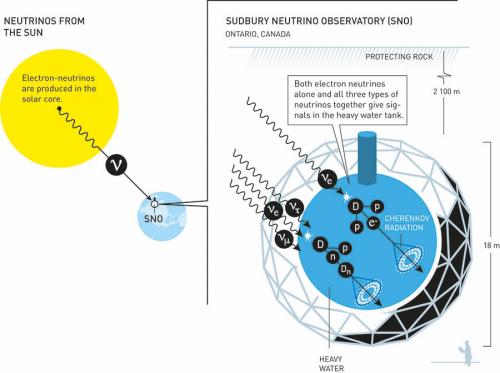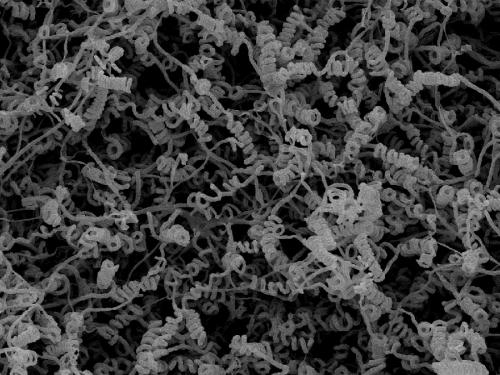The Royal Swedish Academy of Sciences has decided to award the Nobel Prize in Physics for 2015 to Takaaki Kajita (Super-Kamiokande Collaboration, University of Tokyo, Kashiwa, Japan) and Arthur B. McDonald (Sudbury Neutrino Observatory Collaboration, Queen’s University, Kingston, Canada)
for the discovery of neutrino oscillations, which shows that neutrinos have mass.
The Nobel Prize in Physics 2015 recognises these scientists for their key contributions to the experiments that demonstrated that neutrinos change identities. This metamorphosis requires that neutrinos have mass. The discovery has changed our understanding of the innermost workings of matter and can prove crucial to our view of the universe.
Around the turn of the millennium, Takaaki Kajita presented the discovery that neutrinos from the atmosphere switch between two identities on their way to the Super-Kamiokande detector in Japan.
Meanwhile, the research group in Canada led by Arthur B. McDonald could demonstrate that the neutrinos from the Sun were not disappearing on their way to Earth. Instead they were captured with a different identity when arriving to the Sudbury Neutrino Observatory.
A neutrino puzzle that physicists had wrestled with for decades had been resolved. Compared to theoretical calculations of the number of neutrinos, up to two-thirds of the neutrinos were missing in measurements performed on Earth. Now, the two experiments discovered that the neutrinos had changed identities.
The discovery led to the far-reaching conclusion that neutrinos, which for a long time were considered massless, must have some mass, however small.
For particle physics this was a historic discovery. Its standard model of the innermost workings of matter had been incredibly successful, having resisted all experimental challenges for more than 20 years. However, as it requires neutrinos to be massless, the new observations had clearly showed that the standard model cannot be the complete theory of the fundamental constituents of the universe.
The discovery rewarded with this year’s Nobel Prize in Physics has yielded crucial insights into the all but hidden world of neutrinos. After photons, the particles of light, neutrinos are the most numerous in the entire cosmos. The Earth is constantly bombarded by them.
Many neutrinos are created in reactions between cosmic radiation and the Earth’s atmosphere. Others are produced in nuclear reactions inside the Sun. Thousands of billions of neutrinos are streaming through our bodies each second. Hardly anything can stop them passing; neutrinos are nature’s most elusive elementary particles.
The experiments continue and intense activity is underway worldwide in order to capture neutrinos and examine their properties. New discoveries about their deepest secrets are expected to change our current understanding of the history, structure and future fate of the universe.
The Nobel Assembly at Karolinska Institutet has decided to award the 2015 Nobel Prize in Physiology or Medicine with one half jointly to William C. Campbell and Satoshi Õmura
for their discoveries concerning a novel therapy against infections caused by roundworm parasites
and the other half to Youyou Tu
for her discoveries concerning a novel therapy against malaria.
Diseases caused by parasites have plagued humankind for millennia and constitute a major global health problem. In particular, parasitic diseases affect the world’s poorest populations and represent a huge barrier to improving human health and wellbeing. This year’s Nobel Laureates have developed therapies that have revolutionised the treatment of some of the most devastating parasitic diseases.
William C. Campbell and Satoshi Õmura discovered a new drug, avermectin, the derivatives of which have radically lowered the incidence of river blindness and lymphatic filariasis, as well as showing efficacy against an expanding number of other parasitic diseases. Youyou Tu discovered artemisinin, a drug that has significantly reduced the mortality rates for patients with malaria.
These two discoveries have provided humankind with powerful new means to combat these debilitating diseases that affect hundreds of millions of people annually. The consequences in terms of improved human health and reduced suffering are immeasurable.
We live in a biologically complex world, which is populated not only by humans and other large animals, but also by a plethora of other organisms, some of which are harmful or deadly to us.
A variety of parasites cause disease. A medically important group are the parasitic worms (helminths), which are estimated to afflict one-third of the world’s population and are particularly prevalent in sub-Saharan Africa, South Asia and Central and South America. River blindness and lymphatic filariasis are two diseases caused by parasitic worms. As the name implies, river blindness (onchocerciasis) ultimately leads to blindness, because of chronic inflammation in the cornea. Lymphatic filariasis, afflicting more than 100 million people, causes chronic swelling and leads to life-long stigmatising and disabling clinical symptoms, including elephantiasis (lymphedema) and scrotal hydrocele.
Malaria has been with humankind for as long as we know. It is a mosquito-borne disease caused by single-cell parasites, which invade red blood cells, causing fever, and in severe cases brain damage and death. More than 3.4 billion of the world’s most vulnerable citizens are at risk of contracting Malaria, and each year it claims more than 450 000 lives, predominantly among children.
After decades of limited progress in developing durable therapies for parasitic diseases, the discoveries by this year’s Laureates radically changed the situation.
Satoshi Õmura, a Japanese microbiologist and expert in isolating natural products, focused on a group of bacteria, Streptomyces, which lives in the soil and was known to produce a plethora of agents with antibacterial activities (including streptomycin discovered by Selman Waksman, Nobel Prize 1952). Equipped with extraordinary skills in developing unique methods for large-scale culturing and characterisation of these bacteria, Õmura isolated new strains of Streptomyces from soil samples and successfully cultured them in the laboratory. From many thousand different cultures, he selected about 50 of the most promising, with the intent that they would be further analysed for their activity against harmful microorganisms.
William C. Campbell, an expert in parasite biology working in the US, acquired Õmura’s Streptomyces cultures and explored their efficacy. Campbell showed that a component from one of the cultures was remarkably efficient against parasites in domestic and farm animals. The bioactive agent was purified and named avermectin, which was subsequently chemically modified to a more effective compound, ivermectin. Ivermectin was later tested in humans with parasitic infections and effectively killed parasite larvae (microfilaria). Collectively, Õmura’s and Campbell’s contributions led to the discovery of a new class of drugs with extraordinary efficacy against parasitic diseases.
Malaria was traditionally treated by chloroquine or quinine, but with declining success. By the late 1960s, efforts to eradicate malaria had failed and the disease was on the rise. At that time, Youyou Tu in China turned to traditional herbal medicine to tackle the challenge of developing novel malaria therapies. From a large-scale screen of herbal remedies in malaria-infected animals, an extract from the plant Artemisia annua emerged as an interesting candidate. However, the results were inconsistent, so Tu revisited the ancient literature and discovered clues that guided her in her quest to successfully extract the active component from Artemisia annua. Tu was the first to show that this component, later called artemisinin, was highly effective against the malaria parasite, both in infected animals and in humans. Artemisinin represents a new class of antimalarial agents that rapidly kill the malaria parasites at an early stage of their development, which explains its unprecedented potency in the treatment of severe malaria.
The discoveries of avermectin and artemisinin have fundamentally changed the treatment of parasitic diseases. Today the avermectin-derivative ivermectin is used in all parts of the world that are plagued by parasitic diseases. Ivermectin is highly effective against a range of parasites, has limited side effects and is freely available across the globe. The importance of ivermectin for improving the health and wellbeing of millions of individuals with river blindness and lymphatic filariasis, primarily in the poorest regions of the world, is immeasurable. Treatment is so successful that these diseases are on the verge of eradication, which would be a major feat in the medical history of humankind. Malaria infects close to 200 million individuals yearly. Artemisinin is used in all malaria-ridden parts of the world. When used in combination therapy, it is estimated to reduce mortality from malaria by more than 20% overall and by more than 30% in children. For Africa alone, this means that more than 100 000 lives are saved each year.
The discoveries of avermectin and artemisinin have revolutionised therapy for patients suffering from devastating parasitic diseases. Campbell, Õmura and Tu have transformed the treatment of parasitic diseases. The global impact of their discoveries and the resulting benefit to mankind are immeasurable.





